FESTIVITIES

 HERITAGE TRAVELLERS eTwinning Project 2022-2023
HERITAGE TRAVELLERS eTwinning Project 2022-2023
Cultural heritage is a collection of important assets of a culture that are preserved through societal memory, meaning that it is passed down from generation to generation.
Cultural heritage includes tangible assets like books, tools, clothing, food, artwork, and archaeological discoveries, along with intangible assets such as music, dance, craftsmanship, rituals, rites , gastronomy, festivities and clothing.
The students from the e Twinning project Heritage Travellers have worked in international teams and have found elements of intangible heritage examples in their countries (Italy,France,Greece,Romania and Spain).


SANT JOAN'S DAY

ThenightofSanJoaniscelebratedonthedays23rdto24th ofJune.Itisamagicalnightcalled"thenightofFire"or"the nightofthewitches".Itisthemomentwhenwesaygoodbye tospringandwewelcomesummer.OnCostaBravaandthe GironaPyrenees,asintherestofCatalonia,thefestivityof SanJoan("revetlladeSantJoan"inCatalan)ispartofour festiveheritage.Wegatherwithfamilyandfriendsaround bonfires, following ancestral rites accompanied by music, dancing, lots of fireworks, and, in Catalonia, with the traditionalSantJoancake,madewithsweetbreaddough, pastrycream,andcandiedfruits.

 Marc Rigo
Marc Rigo
THE THREE WISE MEN
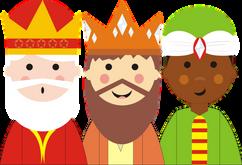
January6thisauniquedateexpectedbythousandsofchildren whowillreceivefungiftsfromtheThreeWiseMen,without neglectingadultswhowillenjoyseeingsmilesandenjoyingthe traditional"Roscadereis"andchocolatewiththecompanyof thefamily.The3wisemenrepresenttheagesofthehuman being: youth (Gaspar), maturity (Baltasar), and old age (Melchior).OnthedayofthebirthofJesus,thesekingscame fromtheeastofJerusalemtoBethleheminJudea,andthey gavegifts.SincethatdayeveryJanuary6ththereareparades inwhichtheydistributecandiesandgiftsforchildren.
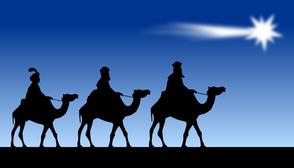
SANT JORDI'S DAY

“LaDiadadeSantJordi”inCataloniaisaholidaycelebrated on23AprilwithBookDayandtheRosesFair,symbolsof cultureandlove,andisalsoadaythatclaimsCatalanculture. Thistraditionisbasedonalegendofagentlemanwho,outof loveforhisprincesscalledCleodolinda,killsafiercedragon whowantedtoeather.Itisthedayofthelovers,andsincethe 15thcentury,ithasbeencustomarytopresentaredrose"like thebloodofthedragon"tothegirl.Also,inthe1930s,the customofgivingabooktotheboyappears,becauseitisthe dayofthebook.

THE "CASTANYADA"
"La Castanyada" is a festivity celebrated in the Catalan Countriesonthe1stofNovember(althoughsomecelebrateit onthe31stofOctober).Duringit,everyoneeatschestnuts, sweetpotatoes,andasweetdessertnamed"panellet".People gather around a campfire and they cook the chestnuts together while they sing popular songs and share stories. There's a characteristic character related to these dates named"LaCastanyera",anoldwomanwhosellschestnutson thestreet.Thisfestivityoriginatesfromoldfuneraryritesof theXVIIIcentury,wherepeopleonlyatenutsandlegumes.


VALENCIAN "FALLAS"

Thisfestivallastsfivedays,fromMarch15to19,butitreally starts on March 1, when a show begins with thunderous firecrackers,formingthemascletáeverydayat2:00p.m.in theTownHallSquare.ThefestivalreallytakesshapeonMarch 15,withLaPlantà,whenmorethan700hugeninotsareplaced throughoutthecity,thusclosingmostofthestreetstotra�ic. Inthisway,thestreetsarefilledwithpeopleandactivities duringthesedaysandnightsoffestivities.Themainmoment ofLasFallasisthecreationanddestructionoftheninots, whicharelargestatuesmadeofpapier-mâché,cardboard, woodorgauze.Theninotsareextremelyrealisticandusually showsatiricalscenesorcurrentevents.

Holy week (Semana Santa)


HolyWeekisafestivitythatiscelebratedinaperiodofeight daysthatbeginswithPalmSundayandendswithResurrection Sunday. With Holy Week, the Christian commemorates the moments of the Passion, Death and Resurrection of Jesus Christ.Duringthosedayspeopleeataspecifictypeoffood, manyofthemtraditional.Inaddition,familiesmeettocarry outvariousactivitiestogether.Thisyear,thecelebrationwill takeplacefromSunday,April2,toSunday,April9.
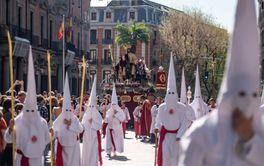
May 8th
Celebration of the Victory in the World
War II
Public Holiday since 1953

Monday of Pentecôte

Public Holiday
Christian celebration
February 14th: Saint Valentin
Paris as the lovers' city, lot of couples french or foreigns go to the City of Lights

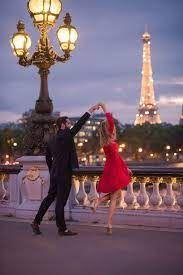
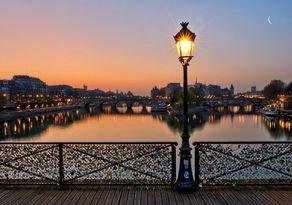
The 'Great Blessing of the Waters' that takes place on Epiphany is a religious festival. This ceremony is usually performed twice, once on the eve of Epiphany which is performed in the church, and then again on the actual day outdoors with priests blessing large bodies of water, sea, rivers, lakes etc.


The tradition is that a priest, surrounded by young men and boys, throws a cross into the sea. The minute the cross leaves the priest’s hand, the divers jump into the freezing water to catch the cross. The lucky one who finds and returns the cross is blessed by the priest. As the cross is victoriously brought back, the priest releases a white dove, as a symbol of the holy spirit.
 Silia, Greece
Silia, Greece
The Patras Carnival, or Patrino karnavali, is the largest event of its kind in Greece. It has more than 180 years of history. The events begin on 17 January and last up to Clean Monday. The carnival of Patras is not a single event but a variety of events that includes balls, parades, hidden treasure hunt and the children's carnival amongst others. Its characteristics are spontaneity, improvisation, inspiration and volunteerism. In 2019, there were about 750.000 participants in the carnival!

 Johanna Gr
Johanna Gr
The Athens Epidaurus Festival is Greece’s leading cultural organisation and one of the oldest continuously running festivals in Europe. Spanning 67 years, the Festival has welcomed some of the greatest music, dance, and theatre artists of the international and local scene, in collaboration with the most prestigious Greek and international organisations, attracting large audiences from around the world. An annual event since 1955, the festival goes on throughout the summer, providing plenty of opportunities to catch a show in one of the original, ancient amphitheaters of Greece. Featuring everything from big productions of famous ancient Greek plays, to concerts, visual art productions and dance performances, the festival has grown in recent years and now also takes place at modern venues of the capital.
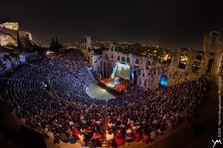
 Georgia Greece
Georgia Greece
The Athens Epidaurus Festival is Greece’s leading cultural organisation and one of the oldest continuously running festivals in Europe. Spanning 67 years, the Festival has welcomed some of the greatest music, dance, and theatre artists of the international and local scene, in collaboration with the most prestigious Greek and international organisations, attracting large audiences from around the world. An annual event since 1955, the festival goes on throughout the summer, providing plenty of opportunities to catch a show in one of the original, ancient amphitheaters of Greece. Featuring everything from big productions of famous ancient Greek plays, to concerts, visual art productions and dance performances, the festival has grown in recent years and now also takes place at modern venues of the capital.

 Georgia Greece
Georgia Greece
Tradition, culture, folklore and food and wine at the Sagra del carciofo di Uri (Artichoke Festival of Uri), a town in northern Sardinia.This is an identity event that recalls the history of the town, which has had a vocation for artichoke growing since the mid-eighteenth century and has exponentially grown its number of visitors over the years.

Sagra del Carciofo di Uri
CLOTHING

 HERITAGE TRAVELLERS eTwinning Project 20222023
HERITAGE TRAVELLERS eTwinning Project 20222023
Cultural heritage is a collection of important assets of a culture that are preserved through societal memory, meaning that it is passed down from generation to generation.
Cultural heritage includes tangible assets like books, tools, clothing, food, artwork, and archaeological discoveries, along with intangible assets such as music, dance, craftsmanship, rituals, rites , gastronomy, festivities and clothing.
The students from the e Twinning project Heritage Travellers have worked in international teams and have found elements of intangible heritage examples in their countries (Italy,France,Greece,Romania and Spain).


In each place in Spain, there is a typical dress and a differenttypeofclothing.


For this reason, we will find this book divided into some autonomous communities of Spain, where the typical clothingofthesecommunitieswillbeexplained.
-Andalusia
-GaliciaandAsturias
-Madrid
-BalearicIslands
-ValencianCommunity

-Catalonia
-Aragon
-TheRioja
-Murcia
Alba Garcés - Spain
TYPICALDRESSOFANDALUSIA
The common Andalusian dress is the flamenco dress, or gypsydress.

The women wear a long, fitteddresswithruffles. The most common accessories are the flower,thecombandthe shawl.
In the case of men, they wear pants, a white shirt, a short jacket, a sash and a vest, accompanied by a Cordovanhat.
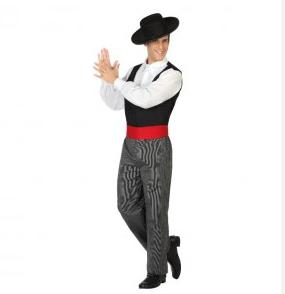
 Alba Garcés - Spain
Alba Garcés - Spain
TYPICALCLOTHINGOFGALICIA ANDASTURIAS
Galicia and Asturias are autonomous communities that use very similar traditional clothing, so we are going to groupthemtogetherinthesameepisode.
It is a type of clothing used by the peopleoftheareaduringthe20th century.

Women wear a long skirt, a black apron, a white blouse, a waistcoat and a black cape crossed on the chest.
 Leo - Spain
Leo - Spain
Men, on the other hand, wear a white shirt, waistcoat, sash, black breeches and a cloth that goes from the knee tothefeet.


And this is the combination of art they create when thetwostylesarecombinated.
 Leo - Spain
Leo - Spain
TYPICALDRESSOFMADRID
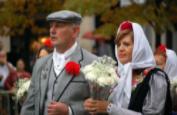
ThechulaposandchulapasgotothestreetstopraytoSan Isidro. Women do it in a tight dress with ruffles at the bottom, a shawl, and a white scarf on her head, with flowers.
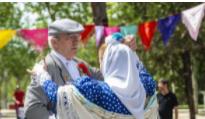
The men ' s clothing consists of dark pants, a white shirt, a vestwithacarnation,andawhitehandkerchief.
 Harsheen - Spain
Harsheen - Spain
TYPICALDRESSOFBALEARICISLANDS
Thepeasantcostumeisthemosttypical.Thewomenwear adoubletandskirtswithpetticoatsandhoopskirts.Onthe head,acap.
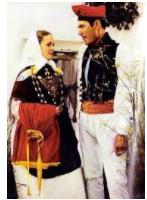

The men wear baggy pants up to the knees, or long white ones,asash,awhiteshirtwithacape,andahatorscarf.
 Harsheen - Spain
Harsheen - Spain
TYPICALDRESSOFVALENCIANCOMMUNITY


The falleros and the falleras wear the most typical costumes.
The women with patterned skirts, bodices, aprons and tablecloths.
Men,pantsandjacket,whiteshirtandsash.
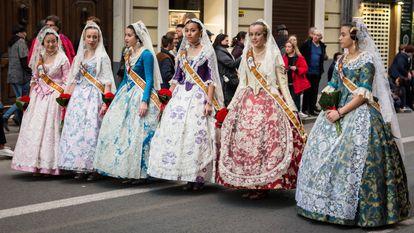 William Wu - Spain
William Wu - Spain
TYPICALDRESSOFTHERIOJA

The one that stands out the most is that of Albelda de Iregua.
The men wear a white shirt, two colored ribbons tied on each side, four ribbons on their arms, and a scarf around their necks.
The woman wears a shirt the same as the man's with knee-length shorts with their colored ribbons, in addition to the sash.


 Ronald Cruz - Spain
Ronald Cruz - Spain
TYPICALDRESSOFMURCIA
In the region of Murcia, the woman wears a colored bodice, slip or skirt, white shirt, cloak and apron.

For his part, the man wears a shirt, embroidered vest, breeches, shorts and stockings. In addition to the red sash and on the feet, the espardeñas.
 Ronald Cruz - Spain
Ronald Cruz - Spain
Clothing in ancient Greece
Clothing in ancient Greece primarily consisted of the chiton, peplos, himation, and chlamys. Ancient Greek civilians typically wore two pieces of clothing draped about the body: an undergarment

Ancient Greek clothing was mainly based on necessity, function, materials, and protection rather than identity. Thus, clothes were quite simple, draped, loose-fitting and free-flowing. Clothing was homemade and cut to various lengths of rectangular linen or wool fabric with minimal cutting or sewing, and secured with ornamental pins, and a belt.
 Maria and Christina GREECE
Maria and Christina GREECE
Tsarouchi- Traditional Greek Shoe


A tsarouchi is a type of shoe, which is typically known nowadays as part of the traditional uniform worn by the Evzones of the Greek Presidential Guard. They were the most common footwear worn by both urban and rural Greeks, mainly men, but also many women. Tsarouchia are typically made of stiff leather hand-sewn together, in the moccasin fashion. They have a characteristic upturned toe, usually covered by a large woolen pompon.
 Athina- Catherine GREECE
Athina- Catherine GREECE
Sandals

In Ancient Greece sandals were the most common type of footwear that women wore and spent most of their time at home. The Greek sandals featured a multitude of straps with which they securely fastened to the foot. The top of the sandals were usually of colored leather. The soles were made of cattle skin, of even better quality and made up of several layers.
 Christina and Maria GREECE
Christina and Maria GREECE
Fustanella
Fustanella is a traditional pleated skirt-like garment that is also referred to as a kilt worn by men of many nations in the Balkans. In modern times, the fustanella is part of Balkan folk dresses. In Greece, a short version of the fustanella is worn by ceremonial military units such as the Evzones. According to one view, the fustanella was already in common use in Greek lands as early as the 12th century.

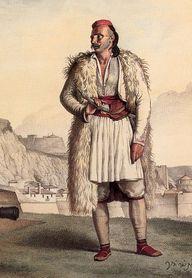
 Catherine- Athina
Catherine- Athina
Le Béret Basque

It is a cap made of soft felt or knitted and felted wool, of circular and flat shape, generally decorated with a crown This type of hat without a brim has existed since the Middle Ages under other names in the various countries of Europe, often with a wider shape. The Basque beret is quite famous and is worn a lot in the South East of France.

French haute couture


This is an industry very important in France for economic and artistic reasons. It is a great contribution to the prestige of our country. Coco Chanel is a major figure in this art. The Hermes scarf is part of our national heritage.

CRAFTMANSHIP
HERITAGE TRAVELLERS eTwinning Project 2022-2023


Cultural heritage is a collection of important assets of a culture that are preserved through societal memory, meaning that it is passed down from generation to generation.
Cultural heritage includes tangible assets like books, tools, clothing, food, artwork, and archaeological discoveries, along with intangible assets such as music, dance, craftsmanship, rituals, rites , gastronomy, festivities and clothing.
The students from the e Twinning project Heritage Travellers have worked in international teams and have found elements of intangible heritage examples in their countries (Italy,France,Greece,Romania and Spain).


SPONGE DIVING

The History and Tradition of Sponge Diving in Kalymnos, in the Dodecanese. The island of Kalymnos in the Aegean Sea is known as the center of the Greek sponge diving industry, which has developed on the island since the ancient times.
Sponge diving has been called "the oldest profession" on the island of Kalymnos. The sponge diving industry contributed immensely to the economic and social development of the island a few decades ago.
 Thalia and Evi GREECE
Thalia and Evi GREECE
The traditional handicrafts of Greece were initially born out of necessity. Yet, they are also objects of remarkable beauty. One of the oldest crafts from antiquity that is still appreciated today is basket weaving.
The supple yet tightly woven, scented willow baskets made of reed and osier that adorn tourist shops on most islands are a happy reminder that these skilled crafters are still in demand. Basket weavers are still around on the islands to repair taverna chairs and other cane furniture as well as sell their decorative and practical baskets to tourists during summers.

BASKETMAKER
The art of pot-making is very famous in Greece and has existed since the ancient years. Although it is not very popular now there are still some craftsmen who make pots and keep the tradition alive.

John Greece
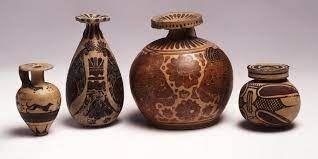
Clay pots
Greek metalwork
Metallurgy is an ancient craft of processing metals that flourished considerably during the years when the Greek popular arts were at their peak.
At the time, metalware objects, mostly made of copper, iron, bronze and lead, were used for agricultural purposes and as ecclesiastical and household utensils.
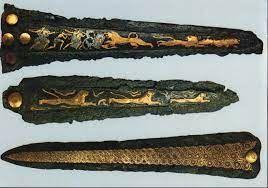
-Thrasyvoulos, Greece

The handicrafts in Spain
Jarapas de la Alpujarra granadina
Typical of Andalusia, those of the Alpujarra region in Granada stand out. The jarapas are generally multicolored rugs that are made with thick fabrics, made of wool or old twisted rags, with a cotton or synthetic fiber warp. These towns in Granada have preserved the tradition and there are several workshops that continue to make them.

 Angely Carranza Romero,
Angely Carranza Romero,
Paella is rice, meat and vegetables cooked over low heat in a hot pan, either pan or stove. It originates from Marjal de l'Albufera de Valencia in the natural area of Ribera del Xúquer, south of Valencia.It is considered a typical dish of the Valencian region.

Throughout Spain, you can find many places that serve delicious paella, but the best place by far is Madrid. Here you can find different types of paella, chicken, black rice, seafood and more.

Andree, Spain
PAELLA
Greek Loom Weaving

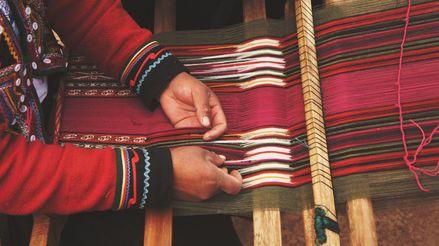
Handloom weaving is a traditional Greek Handloom weaving is a traditional Greek method used in Greece, especially Naxos, method used in Greece, especially Naxos, where clothes are made with the loom device where clothes are made with the loom device in which the weaver has total control of and it in which the weaver has total control of and it allows him to have innovative clothing ideas allows him to have innovative clothing ideas
A loom is a device used to weave A loom is a device used to weave cloth and tapestry. The basic cloth and tapestry. The basic purpose of any loom is to hold the purpose of any loom is to hold the warp threads under tension to warp threads under tension to facilitate the interweaving of the facilitate the interweaving of the weft threads. weft threads.
Nikos from Greece
Since ancient times greeks have been in close assosiation with the sea. As a consequence they have perfected the art of creating as well as repairing ships.
It is tradition that these ships are made of wood, however nowadays it is relatively uncommon to see a wooden ship. In the ancient times, as well as today greeks are known to have one of the strongest fleet armies globally, even among military superpowers like Russia.

SHIPWRIGHT
George Greece
traditional sewing machine


A sewing machine is a machine used to sewfabric and materials together with thread. Sewing machines were invented during the first idustrial Revolution to decrease the amount of manual sewing work performed in clothing companies. Since the invention of the first sewing machine, generally considered to have been the work of Englishman Thomas Saint in 1790, the sewing machine has greatly improved the efficiency and productivity of the clothing industry.
They were very popular in Greece during a period from 1970-2000, these machines were highly used by seamstresses.
from Greece
George
WOOD CARVING
Wood carving is a form woodworking by means of a cutting tool (knife) in one hand or a chisel by two hands or with one hand on a chisel and one hand on a mallet, resulting in a wooden figure or figurine, or in the sculptural ornamentation of a wooden object. The phrase may also refer to the finished product, from individual sculptures to hand-worked mouldings composing part of a tracery

PAINTING EGGS
Painting eggs for Easter is a tradition in Romania, that goes back for centuries.

Painted eggs are a unique element in Romanian culture, which stands testament to the piety and spirituality of the Romanian people. The red egg is a symbol of the renewal of nature and of the seed of life, but the painted Easter egg also bears motifs that engender joy and awe. Religious motifs can be represented, or objects from day-to-day life.
Samit Adrian Mihai,Romania
In the past, wall carpets produced by weavers in communities of Romania and the Republic of Moldova were used not only as decorative features and sources of insulation but also as part of a bride’s dowry. A variety of techniques were needed to produce the pieces with impressive motifs. Certain patterns also indicated where the weaver was from. The carpets had additional roles in community practices, such as at funerals where they symbolized a passage for the soul to the hereafter. They were also displayed at international exhibitions as markers of national identity. These days, wall carpets are mainly appreciated as works of art for public and private spaces and exhibited at city festivals and ceremonies. Viewed as an expression of creativity and identity marker, wall carpet craftsmanship is also considered as a tool to unite groups in society of different ages and socioeconomic backgrounds.

CARPET
WALL
CRAFTMANSHIP
Ironworking in Sardinia is a millennial art evidenced by the findings of the metal age bronzes that began 5000 years ago (3000 BC), thanks to its rich mineral resources. An ancient iron craft tradition is one of the Sardinian knives with a folding blade, the switchblade.

CRAFTSMANSHIP IN ITALY
The Sardinian carpet is not only the floor rug: in Sardinia, it is woven and used also to cover the wooden chests. Its origins seem to be very far, starting with the mats that were already woven in the Neolithic. Then in the Roman and Byzantine era, we may already speak of proper rugs
Nule is famous for its traditional Sardinian wool carpets, a small town where the handmade weaving, performed in accordance with the ancient technique using a vertical loom, is art. They produce woollen carpets with a smooth weave, mainly with a dark background, or the typical “flame” carpet.

The Sardinian ceramic past begins with beautiful specimens of pre-nuragic and nuragic pottery, and models recalling the Roman domination. The making of ceramics takes us back to the courtyards of the houses to find the wells where the clay was to be cleaned from impurities with ageing and washing, the tanks for decanting and the processing made with natural dyes such as certain soils or a mixture of aromatic essences of the Mediterranean scrub. The place for the lathe, the shade where the hand-worked products can be dried, the furnace for the vitrification.
The figulo is the potter and figulina is the art of the potter or the object of terracotta itself.



HERITAGE TRAVELLERS eTwinning Project 20222023 DANCES
Cultural heritage is a collection of important assets of a culture that are preserved through societal memory, meaning that it is passed down from generation to generation.
Cultural heritage includes tangible assets like books, tools, clothing, food, artwork, and archaeological discoveries, along with intangible assets such as music, dance, craftsmanship, rituals, rites , gastronomy, festivities and clothing.
The students from the e Twinning project Heritage Travellers have worked in international teams and have found elements of intangible heritage examples in their countries (Italy,France,Greece,Romania and Spain).
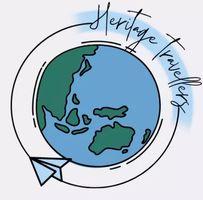

The sardanes are a very traditional dance in Spain, especially in Catalonia, In order to perform the dance, you need a large group of people (usually mixed between men and women).
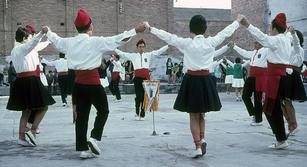

The group dances in synchrony with the music, in a circle, the dancers hold hands and tap their feet in short and long steps, all facing the centre of the circle.
The sardana originated in the province of Girona in 1905.
SARDANES
ADAM & AYA
MUÑEIRA
The muñeira is a traditional Spanish dance, originally from the Galicia region. It is a dance characterized by its fast and elegant movements, with a strong rhythm marked by traditional bagpipe and drum music.

The muñeira is danced in pairs, with the dancers holding their hands together as they spin around the ballroom. It is a very popular dance at parties and traditional celebrations in Galicia.
 ELIZA & PAU
ELIZA & PAU
Kalamatianos is a popular greek dance.The name derives from the city of Kalamata,located in Southern Greece.The music is cheerful and the pace varies depending on the area.


Kalamatianos
This dance is danced by both men and women.The dancers dance in a circle.The first person in the row can improvise and make figures.
Barbara M. Gr
Pendozali
The Pentozali or Pentozalis is the trademark folk dance of the island of Crete.The Pentozali is a war dance, with high jumping movements.It starts at a moderate pace and accelerates progressively. Pentozali music is instrumental: the main tune is played by the pear-shaped, bowed Cretan Lyra, to the accompaniment of a Laouto.
 Michaela V
Michaela V
Both men and women perform the dance, but the steps of the women's dance were traditionally more restrained, because their dress did not allow for high jumps. Traditional Cretan menswear, on the other hand, facilitates acrobatic dancing as it includes the black βράκα (vraka), a variant of breeches that are worn tight around the waist and thighs and extremely baggy and loose around the hips.

Ikariotikos
Ikariotikos is a traditional dance in Ikaria, a Greek island in the North Eastern Aegean Sea. Some specialists say that the traditional Ikariotikos was slow.The name Kariotikos is mostly used by the locals of Ikaria.

 Maria T. Gr
Maria T. Gr
SEVILLANAS
Sevillanas are a traditional dance from Andalucia, Spain. This dance is one of the most recognized popular dances of Spain in the world. It was in the eighteenth century when the sevillanas began to dance.

The sevillanas are composed of three elements: singing, music and dance. There are many ways to dance sevillanas: without a partner, with a partner, in line one after the other. The traditional dress of the dancers are the short costume for him and the flamenco costume for her. In this dance also usually used objects such as the fan or the hat.
The music that accompanies the sevillanas arises as a rule from the strings of a guitar.
VALERIA & MÓNICA
As a stage performance, the jota is sung and danced to the accompaniment of castanets and the performers are usually dressed in regional costumes.
The jota is a traditional dance and song that is widespread throughout much of Spain. Its style varies from region to region.


LA JOTA
Lad's dances are a genre of men's folk dance in Romania practised in community life on festive occasions, such as weddings and holidays, as well as during stage performances. Lad’s dances provide an opportunity for young men to strengthen their social status in traditional communities, particularly among girls and their families in anticipation of marriage.


Traditional Sardinian music, both sung and instrumental, is ancient. The typical folk groups of the "Cantadoris", with their period costumes, periodically enliven the narrow streets of the historical centres.

GASTRONOMY
HERITAGE TRAVELLERS eTwinning Project 2022-

2023

Cultural heritage is a collection of important assets of a culture that are preserved through societal memory, meaning that it is passed down from generation to generation.
Cultural heritage includes tangible assets like books, tools, clothing, food, artwork, and archaeological discoveries, along with intangible assets such as music, dance, craftsmanship, rituals, rites , gastronomy, festivities and clothing.
The students from the e Twinning project Heritage Travellers have worked in international teams and have found elements of intangible heritage examples in their countries (Italy,France,Greece,Romania and Spain).


The Mediterranean Diet

The Mediterranean diet is based on the traditional foods that people used to eat in countries bordering the Mediterranean Sea. The diet encourages fruits, vegetables, whole grains, legumes, nuts, seeds, and heart-healthy fats.

Many studies have now shown that the Mediterranean diet can promote weight loss and help prevent heart attacks, strokes, type 2 diabetes, and premature death.
Stella GREECE
GREEK SALAD ��

A traditional Greek salad consists of sliced cucumbers, tomatoes, green bell pepper, red onion, olives, and feta cheese.������Greek salad is low-calorie and nutrient-dense, also providing you with a vitamins A and C, as well as potassium and ironIt also contains phytonutrients and antioxidants, which reduces the risk of health problems such as heart disease and cancer.��
 Marili GREECE
Marili GREECE
Greek olive oil


The long-standing presence of the olive tree has marked the landscape along with the daily, spiritual and social life of people, creating a special cultural intangible heritage.
The importance of olive tree cultivation is vital so we need to preserve and transmit from generation to generation both practices and knowledge related to olive tree cultivation and harvesting as well as eating habits.
Stella GREECE
Raclette Raclette

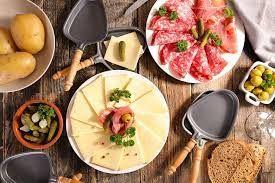 by Louis L.
by Louis L.
Raclette is a traditional French dish that consists of melting a semi-hard cheese, usually raclette cheese, and scraping it onto potatoes and other accompaniments. It is typically served with pickled onions, gherkins, and sometimes cured meats. The dish is often enjoyed as a communal meal and is typically prepared in a special raclette grill. It is enjoyed as a hot meal during winter.
MOUSSAKA
Moussaka is a Greek traditional Mediterranean food. It combines both vegetables and meet. In Greece there are lots of different types of Moussaka. This depends on the geographical region.

Moussaka is a dish that make the Greek gastronomy famous abroad.
 Vasiliki GREECE
Vasiliki GREECE
TORTILLA DE PATATAS
The potato omelette is a typical popular dish of Spain. The omelette is found in some bars and small restaurants as a tapas. the potato omelette makes Spanish gastronomy known throughout the world.

 Angelica Giraldo
Angelica Giraldo
Greek Souvlaki

Souvlaki , is a popular Greek fast food consisting of small pieces of meat and sometimes vegetables grilled on a skewer. It is usually eaten straight off the skewer while still hot. It can be served with or inside of a rolled pita, typically with lemon, vegetables such as sliced tomato and onion, and fried potatoes as a side. It is one of the most popular traditional Greek dishes worldwide

Pane carasau is a traditional flatbread from SARDINIA. It is called carta da musica in Italian , meaning "sheet music", in reference to its large and paper-thin shape, which is said to be so thin before cooking that a sheet of music can be read through it. It is typically paired with pecorino cheese and wine.
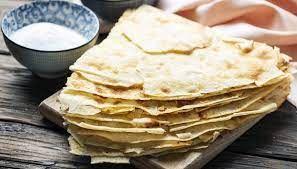
Mămăligă ROMANIA
Like sarmale, mămăligă is one of the most important dishes in traditional Romanian cuisine and considered by many to be a national dish. Similar to polenta, it refers to a type of traditional Romanian porridge made from boiled cornmeal, water, salt, and butter (or sunflower oil).

MUSIC
HERITAGE TRAVELLERS eTwinning Project 20222023


Cultural heritage is a collection of important assets of a culture that are preserved through societal memory, meaning that it is passed down from generation to generation.
Cultural heritage includes tangible assets like books, tools, clothing, food, artwork, and archaeological discoveries, along with intangible assets such as music, dance, craftsmanship, rituals, rites , gastronomy, festivities and clothing.
The students from the e Twinning project Heritage Travellers have worked in international teams and have found elements of intangible heritage examples in their countries (Italy,France,Greece,Romania and Spain).


REBETICO
Rebetiko is a musical and cultural expression directly linked to song and dance that initially spread among the urban lower and working-class populations in the early twentieth century.
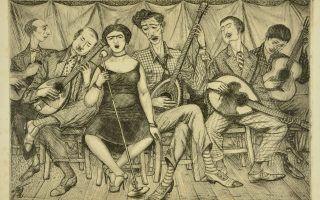
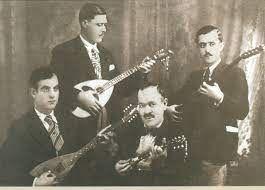
Rebetiko songs are now a standardized repertoire in almost every social occasion involving music and dance. The element is performed in public and performers encourage audience participation.
Rebetiko is, a synthesis of elements of European Music, the music of the various areas of the Greek mainland and the Greek islands,Greek Orthodoxecclesiastical chant , often referred to as Byzantine music, and the modal traditions of Ottoman art music and café music.
Dominic GREECE
Bouzouki
Bouzouki is one of the most wellknown Greek instruments. It was brought in Greece at the early 20th century by immigrants. There are two types of this instrument; the trichordo that has three strings and the tetrachordo that has four strings. It is the most played instrument in Rebetiko music, what Greeks call "Laiko". Because of the Bouzouki a lot of other instruments similar to it have been created. Some of them are the following:
-Tzouras
-Irish bouzouki

-Balkan tambura
-Lute
-Mandolin -Pandura -Baglama -Sargija
Flute
The flute in Greece is known as "floghera". It is a simple bamboo flute with 7 holes. These holes, when covered by the person's fingers, perfform a different musical note. For the most part, it is played in the Greek islands called Kyklades and in Greece.
 Thomas GREECE
Thomas GREECE
Alboka Alboka
The alboka is a reed wind musical instrument that is only found in the Basque Country. The alboka is usually used to accompany a tambourine singer. Its sound is similar to that of the bagpipes and, like this, the sound is uninterrupted. The method used to play is that of continuous insufflation based on the circular breathing technique; with this technique it is possible to breathe without stopping playing.

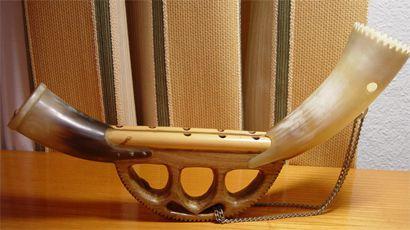
Accordéon

The accordion is a wind musical instrument of the woodwind family. The name accordion brings together a family of polyphonic keyboard instruments, using free reeds excited by a variable wind supplied by the bellows operated by the musician. These different instruments can be of very different invoices.

DULZAINA
The dulzaina is a typical Spanish double reed instrument. It's made of various materials, such as resin and currently what is most used is wood. Dulzaina derives from instruments originating in ancient Mesopotamia. You can hear this instrument in different parts of Spain.


If you want to listen to the sound of dulzaina click on this link:
https://www.youtube.com/watch?v=ZNuVQ7XwgA0
SPAIN - NAVJOT
La copla andaluza is a typical Spanish genre of music that combines music, lyrics and interpretation. It appeared at the end of the 20th century, in the early 20s, and in the 50s it became more popular because it had a very important role in Spanish musical cinema and theater. It provides from the popular songs that people sang and passed down through families, that told stories about the love, disappointments, sadness or happiness that the characters couldn't control.
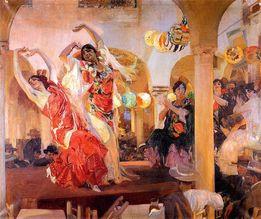

Movies:
Carmen la de Triana (1938), María de la O (1936 and 1938), María Morena (1951), Lola la Piconera (1951)
Singers: Carmen Sevilla, Lolita de Sevilla, Miguel de Molina, Carlos Cano, Raquel Meller, Rocío Jurado, Isabel
Pantoja Songs: María de la O, ¡Ay, penita, pena!, Ojos verdes.
COPLA ANDALUZA
Spain
EL FLAMENCO
Flamenco is a Spanish musical genre that has its origins in Andalusia, in some areas of Extremadura and also in the Region of Murcia. Its main facets are singing, playing and dancing, also having its own traditions and rules.


Spain
Maria Baró- Spain
The Spanish Guitar

The spanish guitar is really similar to the aucustic guitars, but there are also some differences.

Spanish guitars are usally smallers and have a thinner body. They have a brighter and more resonant sound. Sometimes, it is considered as more elegant, too.

Spain
Sardanes
The "sardana" is a popular Catalan dance considered the national dance of Catalonia. It is a collective dance danced by menandwomenwhilethey'reholdingtheirhandstoforminga circle, and tapping with their feet the rhythm of the music playedbythe"copla"(TypicalCatalanmusicgroup).

JOTA
The jota is a traditional dance and song widespread throughout much of Spain. Its style varies according to the regions, existing, for example, the Aragon jota, the Castilian jota, the Manchega jota, the one from León, the one from Valencia etc...
The jota is sung and danced to the accompaniment of castanets and the performers are usually dressed in regional costumes

RITES AND CUSTOMS

 HERITAGE TRAVELLERS eTwinning Project 2022-2023
HERITAGE TRAVELLERS eTwinning Project 2022-2023
Cultural heritage is a collection of important assets of a culture that are preserved through societal memory, meaning that it is passed down from generation to generation.
Cultural heritage includes tangible assets like books, tools, clothing, food, artwork, and archaeological discoveries, along with intangible assets such as music, dance, craftsmanship, rituals, rites , gastronomy, festivities and clothing.
The students from the e Twinning project Heritage Travellers have worked in international teams and have found elements of intangible heritage examples in their countries (Italy,France,Greece,Romania and Spain).
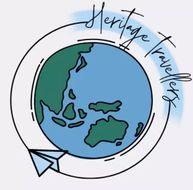

The Momoeri.
The “Momoeri” or “momogeri” is a 12-day ritual marking Christmas, New Year’s and Epiphany. From December 25 to January 5, a group of males mostly dressed as old fighters dance throughout the streets of eight villages in the Kozani area (West Macedonia). The Momoeri is meant to ward off evil through loud noise and teasing. In ancient Greece, the Momos was the god of mockery and teasing.
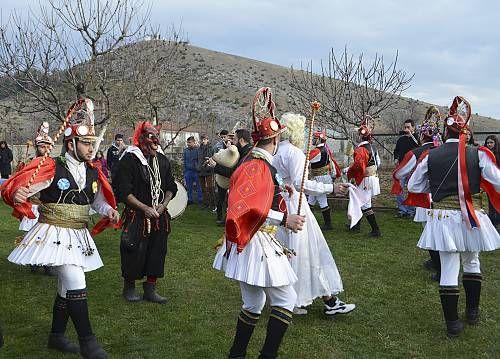 Dimitris L - Greece
Dimitris L - Greece
The Easter Epitaph
The Epitaph represents the dead body of Christ laying on the tomb. The Epitaph starts after the priest is done praising. The epitaph is taken from the church around 9pm by four men. While they are holding the Epitaphios they are walking around all the town followed by the local people. When they finish this important walk they return the Epitaph to the church and they continue the ceremony.
 Iasonas F - Greece
Iasonas F - Greece
Getting together with friends to argue on politics is a typical element of French culture


TALKING ABOUT POLITICS DRINKING WINE
Tsiknopempti
The word Tsiknompempti is a mix of the greek words tsikmo which means the smell of the grilled meat and pempti which means Thursday.


So, this Thursday is the day when you have to eat as much meat as possible. All the taverns and restaurants are full, since people are taking their families out to celebrate and eat grilled meat.
It is also the day when the parties start and the first masquerades for the Greek Carnival make their appearance.
John Gi. Greece
Apokries- the Greek carnival
The Greek Carnival is a celebration with street parties, parades, and masquerades, similar to Carnivals in other Western Christian countries. There are a lot of family friendly events for the little ones that enjoy dressing up.

Like the Latin root of the word “carnival”, the word “apokries” comes from the words apochi and kreas (abstinence and meat) so, “avoiding meat”. The start of the carnival marks the days before the fasting begins. There is not a specific date but it usually takes place between February and March.

Greece
Elisabeth
SPAIN
In this part of the book we are going to talk about the most famous rites and customs of the main Autonomous Communities of the Peninsula. We will share each explanation with a representative image of the Autonomous Community in question.
 Iker Muñoz Cuellar
Iker Muñoz Cuellar
GALICIA
Galicia is an autonomous community of Spain located in the northwest of the Iberian Peninsula. Among its most important customs and traditions are the following:
-Galician Day: July 25 is the national day of Galicia . During this day, numerous concerts and other traditional and cultural events are held throughout the cities in Galicia.


-The “fiadeiros”: This festival usually revolves mainly around traditional dances and music from all over Galicia.
The most popular dance is the muiñeira, which is usually accompanied by music played on instruments such as the tambourine, accordion, tambourine or bagpipe.
-The “Camino de Santiago de Compostela”: This is probably the most famous Galician tradition of all. The Camino de Santiago is a pilgrimage route that has turned Galicia into one of the main pilgrimage centers around the world
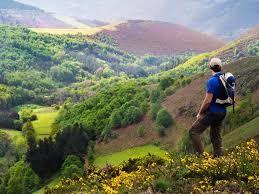 Iker Muñoz Cuellar
Iker Muñoz Cuellar
VALENCIAN COMMUNITY
The Valencian Community is an autonomous community of Spain located in the east of the Iberian Peninsula. We can highlight the following customs and traditions of this place:
-The “Fallas”: Named Intangible Cultural Heritage of Humanity by UNESCO, every March the festival is celebrated with "ninots" - giant cardboard dolls - accompanied by fire and gunpowder. The festival ends with the "Cremà", where all the dolls are burnt.


-The "Magdalena": These festivities mark the beginning of spring and celebrate the origins of the city. For a week, you can enjoy the parade of "gaiatas", concerts, fireworks...
-"Moros and Cristianos" :These historical festivities represent the battle of the Reconquest (a period where the Christians fought against the Muslims to recover the Iberian Peninsula. They feature music, gunpowder and colourful
Iker Muñoz Cuellar
La Rioja
La Rioja is an autonomous community of Spain, located in the north. It is a region well known for its wine, and many of La Rioja’s traditions are related to it. These are the most famous traditions of La Rioja:
The Haro Wine Festival: this festival takes place on the 29th of June, the day of the patron saint San Pedro, in a city called Haro. During this festival, people throw red wine to each other until their clothing is purple. It is a Fiesta of National Tourist Interest in Spain.

La Cata del Barrio de La Estación: this event is celebrated on the 18th of June, in Haro, La Rioja. This event is a guided visit to 6 cellars. You can drink 12 glasses of wine (2 per cellar), 6 caps (1 per cellar) and 1 desert. The ticket costs between 80 and 100€.
 David Buciurca
David Buciurca
Aragon is a region with many customs, traditions and, above all, celebrations. Among them, we will highlight the following two:

- Feast of Saint George: The saint George is worshipped in many places, for example: England and Russia. His most famous tale is his battle against a dragon to save a young princess. The feast of Saint George or Aragon’s day, is celebrated on April 23 in order to honor Saint George as the patron saint of Aragon. During this festivity, people hang the aragon flag on their terraces or windows, and they wear clothes with the national emblem. Also, they eat the traditional dessert called “El Lanzón”.
- La jota aragonesa: Some of the customs of this region are their songs and popular dances called "la jota”. In some Aragonese localities and for special occasions, the citizens wear their typical costumes that consist of headscarves, open breeches and a blanket that is used as a belt.

They sing and dance, accompanied by instruments like the guitar and the lute.
Chaymae Zannouti
Aragon
Castilla y león
Castilla y León is the autonomous community with the largest surface of Spain, also it has nine assets that have been declared World Heritage Sites.
- El Obispillo: it’s an ancient Christmas tradition that is celebrated every December 28 (Day of the Holy Innocents) in the cathedrals of León, Burgos and Palencia.

This tradition consists of choosing one of the children from the choir of a cathedral or monastery, the child who is chosen must wear agarment typical of a bishop. Afterwards, the kid will make a journey through the city on a white horse. At the end of the journey, the child who has been chosen as the "Obispillo" will be in charge of transmitting the wishes on behalf of all the children in the city.
- The dance of sticks of Castilla and León: the dance of sticks consists of a traditional dance in which the participants, wearing white clothes, hit two short sticks that they carry in their hands against each other or against the person in front of them following the rhythm of the music. Usually, they follow a choreography and they are divided into four different acts. There may be a fifth act which it is performed again in front of the spectators. However, the choreographies may vary.
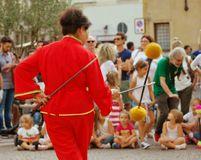
ASTURIES
The International Descent of the Sella : It all starts with a competition between a group of friends who wanted to go down the Sella River in a canoe from Arriondas to its mouth in Ribadesella, 17 kilometers in total. Today, the annual competition is organized by the Royal Spanish Canoeing Federation, brings together more than a thousand paddlers and is a world benchmark in the sport of river descent. But not everything is sport: around the competition, in addition, all kinds of activities and shows take place where there is no shortage of traditional gastronomy, music and dance from morning until the wee hours of the morning.
“La Jira al embalse de Trasona en Corvera.”: Declared National Tourist Interest, it opens the season of popular festivities on May 1st. In this massive celebration, which takes place in the vicinity of the Trasona reservoir, the recreational activities during the day are usually related to water sports. The afternoon gives way to another of the most anticipated moments of the festival: the festival.

Adrià, Spain
The canary ball game: Consists of throwing a ball from an established point with the intention of getting as close as possible to a colored ball, trying to push the opponent away. A Canarian ball match ends when one of the two teams reaches twelve points. Each team can have as many players as they want, as long as each one has the same number.
 Adrià, Spain
Adrià, Spain
Typical canarian costume: The "wizard costumes" are made today with a different class of materials than in ancient times. Wool and linen were the main materials for making the typical clothing: white linen petticoats embroidered in black or red, and the outer petticoat made of sheep's wool dyed black. This was so in the case of some towns on La Palma, since each municipality has its models and variants.

LAS CANARIAS
ILLES BALEARS
The Balearic Islands is an autonomous community of Spain located in the south-west of Europe.
Artisan carpentry

Cossiers
Among the professions transmitted from generation to generation, especially from father to son, that of carpenter is one of the most significant. The arader is the one that has manufactured for centuries the Menorcan barrier, the door that closes the farms, unique in the world, of sheets of wild olive trees. Another, the maestro de ribera, is the one who builds firewood boats of all kinds (especially for fishing and recreation).
Dance and colour. Several towns in Mallorca have the tradition of cossiers, it has its origin in Christianity but also in pagan rituals. They make up a series of ancestral dances performed by six men, a lady and the devil, who simulate a battle between good and evil. The music is provided by the xeremiers and the color, the dresses. Here, the devil always loses

Murcia is an autonomous community of Spain located in the south-east of Europe.
Enterrament de la Sardina: The enterrament de la Sardina is a popular parade that usually serves to close the Carnal, the Saturday after Easter Sunday. In Murcia this event has certain characteristics that make it stand out for its originality. One of its peculiarities is the date on which it is celebrated, since it is celebrated later, after the end of Setmana Santa, just the following weekend.
Bàndol de l’horta This Murcian festival is always celebrated on the first Tuesday after Setmana santa, and opens the Spring Festival cycle.
On this day, the city becomes an extension of the Huerta, in which thousands of people of all ages take to the streets with zaragüelles, vests and monteras (huertano hat), beautiful refajos (skirts), aprons and shawls, regional clothing with its characteristic embroidered ornaments.

MURCIA
Fiestas de San Isidro: No list of Madrid traditions would be complete without mentioning how Madrilènos—the citizens of Madrid—ring in the holiday season. Christmas, for example, has a particul Although tourists can catch one of these events from March through October, the May festivities, organized as part of the San Isidro Fair, are especially thrilling and not to be missed.

MADRID
JINSI, SPAIN
La diada de Sant Jordi: Almost all people living in Catalonia take part in some way, and though traditionally the man gives the woman a single red rose with a strand of wheat, and the woman gives her beloved a book, these days you can find men giving men roses, women giving men roses, men giving women books, women giving women books, and so on. In the following link you can watch a video of Sant Jordi that we made.

Sant Joan: The night of June 23 each year is the celebration of Sant Joan, which was originally a pagan festival. The cities around Catalonia and neighborhoods celebrate the arrival of summer with fireworks, bonfires, and firecrackers. Originally, this tradition was for cleansing from fire and water, and to give more power to the sun. In Barcelona, this festival is celebrated mainly on beaches where there is music and groups of friends / families gatherings.
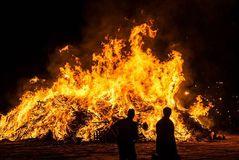
CATALONIA
JINSI, SPAIN

 HERITAGE TRAVELLERS eTwinning Project 2022-2023
HERITAGE TRAVELLERS eTwinning Project 2022-2023





 Marc Rigo
Marc Rigo


















 Silia, Greece
Silia, Greece

 Johanna Gr
Johanna Gr

 Georgia Greece
Georgia Greece








 Leo - Spain
Leo - Spain







 William Wu - Spain
William Wu - Spain


 Ronald Cruz - Spain
Ronald Cruz - Spain




 Christina and Maria GREECE
Christina and Maria GREECE








 Thalia and Evi GREECE
Thalia and Evi GREECE






 Angely Carranza Romero,
Angely Carranza Romero,


















 ELIZA & PAU
ELIZA & PAU


 Michaela V
Michaela V


 Maria T. Gr
Maria T. Gr











 Marili GREECE
Marili GREECE



 by Louis L.
by Louis L.

 Vasiliki GREECE
Vasiliki GREECE

 Angelica Giraldo
Angelica Giraldo








 Thomas GREECE
Thomas GREECE

















 Dimitris L - Greece
Dimitris L - Greece
 Iasonas F - Greece
Iasonas F - Greece






 Iker Muñoz Cuellar
Iker Muñoz Cuellar


 Iker Muñoz Cuellar
Iker Muñoz Cuellar



 David Buciurca
David Buciurca





 Adrià, Spain
Adrià, Spain






